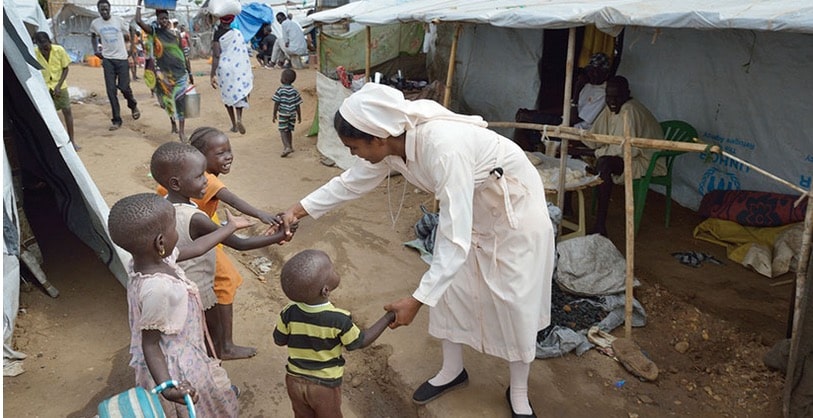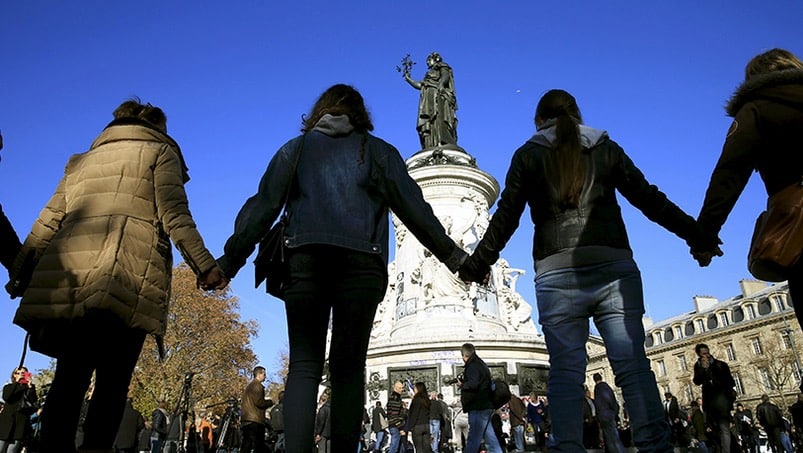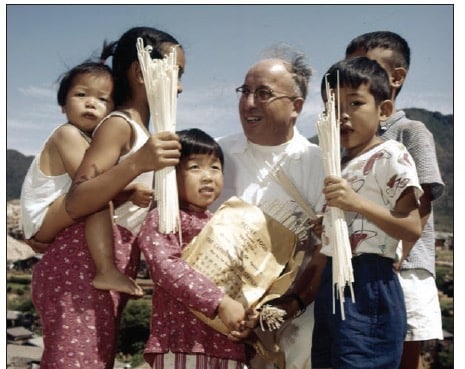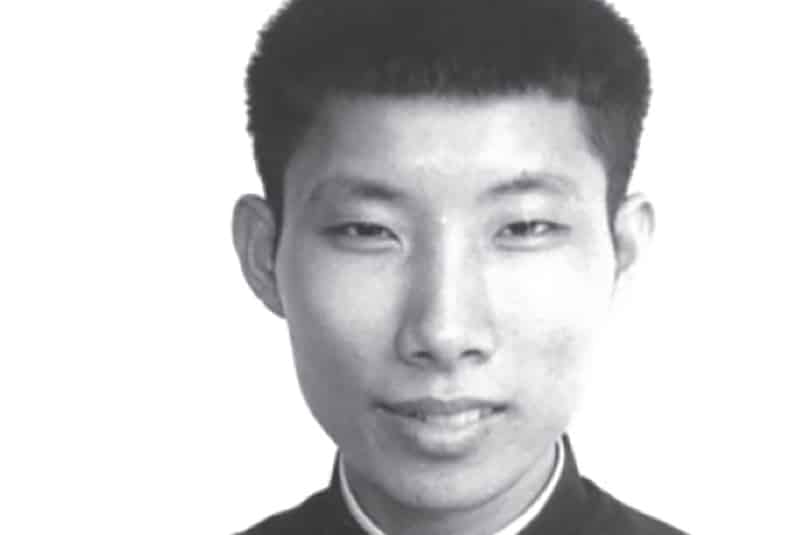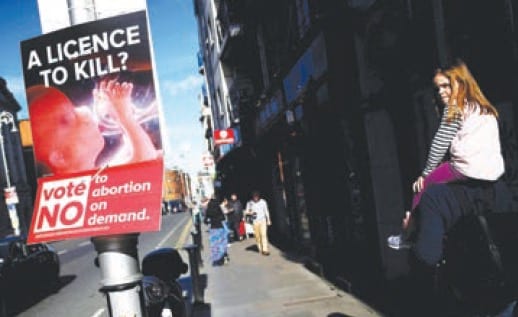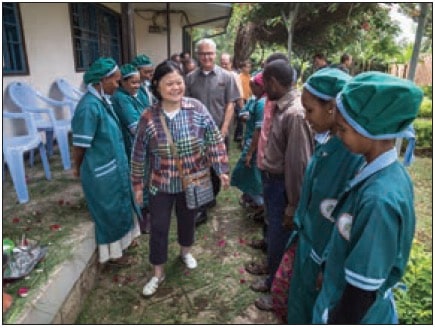As the world prepares for Pope Francis’ visit in November to the Central African Republic and Kenya, focus is turning to the Church in Africa, one of the most remarkable stories in the history of evangelization. At the start of the 20th century, there were barely 2 million Catholics on the continent, and most were Europeans who belonged to powers that controlled almost all of Africa.
Today, there are more than 200 million Catholics, virtually all of them native Africans. According to a new study by the Center for Applied Research in the Apostolate, since 1980, the Catholic population has dramatically risen by 238 percent, the largest growth anywhere in the world.
To be sure, the continent faces immense challenges: endemic poverty and disease, political corruption, economic instability, the crises caused by globalization and exploitation of human and natural resources, and the violent march of radical Islam. But Africa is also home to a young, vibrant and dedicated Catholic community that is swiftly taking its place as a leader in global Catholicism.
At the special synod of bishops held in 2009 on the Church in Africa, then-Pope Benedict XVI acknowledged the immense problems facing Africa, but he also described Africa as “an immense spiritual ‘lung’ for a humanity that appears to be in a crisis of faith and hope.”
Africa is the second largest continent, home to more than 1 billion people, 56 recognized countries and some of the world’s greatest geographical and cultural diversity. The people of Africa live in the starkest of deserts, verdant forested jungles, rich grasslands and teeming cities such as Lagos, Cairo and Kinshasa.
To visit Africa is to see staggering poverty, inequality and seemingly insuperable political and social dilemmas. But it is also possible to gaze upon intense faith, joy in the face of travail and hope in the eyes of the young.
The challenge and hope of Africa were expressed well by the African bishops who attended the special 2009 synod: “Rich in human and natural resources, many of our people are still left to wallow in poverty and misery, wars and conflicts, crisis and chaos. These are very rarely caused by natural disasters. They are largely due to human decisions and activities by people who have no regard for the common good …
“But Africa must not despair. The blessings of God are still abundant, waiting to be prudently and justly employed for the good of her children.”
The Church in Africa
While Christianity in sub-Saharan Africa effectively dates back only two centuries, the faith in Africa dates to the first century, when the earliest Christians made their way to the great city of Alexandria, Egypt. While the Church in North Africa was all but destroyed by the Islamic invasions of the seventh century, a millennium later, sub-Saharan Africa proved open to the Gospel.
In their document, “A Call to Solidarity with Africa,” the U.S. bishops wrote, “Catholic missionaries, responding to Christ’s mandate to preach to and teach all peoples, carried the message of Christian hope throughout the continent. These dedicated witnesses cared for people in all dimensions of their lives: spiritual, physical and social.
They introduced systems of education and health care that continue to serve the needs of millions throughout the continent. And they shared with the world the values and insights gained from deep communion with the Church and its members in Africa.”
Nevertheless, for much of the first half of the 20th century, the Catholic population of Africans remained modest, partly because of the cultural perception that Christianity was exclusively European and the legacies of colonialism and the slave trade. This changed from the time of the Second Vatican Council (1962-65) and especially the pontificate of Pope St. John Paul II (1978-2005), who made 14 separate trips to the continent.
Christianity today is the fastest growing religion in Africa, outpacing even Islam. It is important to qualify, however, that Christian populations in North Africa are tiny, in such countries as Algeria, war-torn Libya, Somalia (where celebrating Christmas was declared a crime) and Tunisia.
The largest Catholic populations are found in sub-Saharan Africa, especially Central and East Africa, including the Democratic Republic of Congo, Tanzania, Uganda, Cameroon and Nigeria. In many of these countries, the Catholic population is rivaled by the Muslims, such as in Nigeria, Liberia and Tanzania. In Southern and some East African countries, such as South Africa, Kenya, Zimbabwe and Zambia, the population is majority Christian, but Catholicism is not dominant.
The population of Africa is also incredibly young. The average age is 18 years, and 40 percent of Africans, 416 million, are 14 years old or younger. According to the Center of Applied Research in the Apostolate, the number of Catholics will increase to 460.4 million by 2040.
Sacramental life for Africans is a rich one. Pope St. John Paul II in his apostolic exhortation Ecclesia in Africa in 1995, wrote, “Africans have a profound religious sense, a sense of the sacred, of the existence of God the Creator and of a spiritual world. The reality of sin in its individual and social forms is very much present in the consciousness of these peoples as is also the need for rites of purification and expiation.”
| African Catholic Population 1960-Today |
|---|
|
1960: 22,855,000
1978: 48,528,000
2014: 206,224,000 (Sources: Annuarium Statisticum Ecclesiae, Annuario Pontificio, CSMC World Mission Map, 1960, Catholic Almanac.)
|
In countries like Nigeria and Congo, parishes regularly schedule four or five Masses every Sunday, and Mass attendance in the more than 16,000 parishes typically hovers around 70 percent. The Church in Africa now celebrates one-fourth of all of the world’s baptisms.
According to the U.S. Conference of Catholic Bishops, more and more African priests “are engaging in ‘mission in reverse,’ coming to the West to help re-evangelize Europe and North America.”
African dioceses are enjoying a bountiful harvest of priestly vocations. Presently, there are nearly 42,000 priests in Africa, more than one-tenth of the world’s priestly population. They now also boast almost 42,000 of the world’s 115,500 seminarians, nearly 40 percent. In 1960, Africa had a little more than 2,000 seminarians.
In their 2001 statement, “A Call to Solidarity with Africa,” the U.S. bishops’ conference called on all Catholics to stand with Africa as the continent moves forward in the new century. They wrote:
“Africa is not a continent of despair. It is rather a place of people who are struggling to overcome past problems and current challenges in order to build a future of hope and opportunity.
“The world community owes much to the peoples of Africa. Africa has always served other nations as a source of rich human and material resources.”
Still, the issues confronting the governments of the continent are daunting: the legacy of colonialism; political corruption; poverty, combined with rapid urbanization, environmental degradation and economic exploitation; social and tribal conflicts, exemplified by the genocidal wars that plagued Rwanda, Burundi and Uganda; disease; poor education; and ideological colonization by the West.
Political instability and the call for unity
Recent years have seen serious pan-African movements led by the African Union (AU) to promote economic development and continental integration, but one of the most enduring problems in the post-colonial period of Africa has been the establishment of genuinely stable governments.
| 30% of the population south of the Sahara is Muslim, while Muslims dominate in the north. |
Catholic leaders have been especially prominent in bringing an end to civil wars, speaking out against corruption and helping the transition toward functional democracy. In the Democratic Republic of Congo, for example, in 2011, Cardinal Laurent Monsengwo Pasinya encouraged independent observers for the disputed re-election of President Joseph Kabila, and the bishops of Congo condemned the disastrous political situation. The Church today is the only stable institution in a country ravaged by civil strife, corruption and poverty.
In Zimbabwe, Bishop Pius Ncube of Bulawayo and other Church leaders were outspoken against the corruption of Robert Mugabe’s regime as well as its failure to implement authentic land reforms. Church officials have been murdered and attacked in countries such as Cameroon and Burundi, where the apostolic nuncio was murdered in 2003.
Poverty, disease and education
The different regions of Africa boast some of the world’s most abundant natural resources, including gold, oil, diamonds, precious woods, copper, cocoa and cobalt. Nearly 15 percent of U.S. oil imports come from the African continent, and African nations have tried to fashion a strategic framework for development called NEPAD, New Partnership for Africa’s Development.
And yet, Africa remains a place of staggering poverty, limited medical care and illiteracy. More than 40 percent of people in sub-Saharan Africa continue to live in absolute poverty, 240 million people (one-third of the population) live with chronic hunger issues and nearly half survive on income that is less than $1.25 a day. Some 40 percent of the world’s refugees are from Africa, displaced by war, political unrest and famines in the Great Lakes region, Northern Uganda, South Sudan, Darfur, Guinea and Conakry. Other populations are on the move because of the lack of work, deforestation, erosion, desertification and water shortages. Urbanization in places like Angola, Kenya, Nigeria and South Africa is also exacerbating urban poverty and disease.
Catholic organizations and apostolates are invested heavily in Africa. Catholic Relief Services works in 37 African nations across sub-Saharan Africa as well as in North Africa. Their main program areas are in food security, peace building, HIV and AIDS, civil society building and emergency response. Programs range from helping people in Tanzania develop micro-finance and grow crops to Malawi with the Transparent Initiative with our Natural Extractives (TIWONE) to reduce corruption within the uranium, coal and niobium mining sectors and ensure that all Malawians eventually benefit. CRS has some 2,000 staff in sub-Saharan Africa, joined by the many other Catholic organizations such as Caritas Internationalis, the Catholic Campaign for Human Development and Aid to the Church in Need.
At a time when malaria medications cost pennies in the developed world, 1 million Africans die of malaria every year. Around 85 percent of the victims are children under the age of 5. The scourge of HIV/AIDS also continues, with 25 million HIV/AIDS patients in sub-Saharan countries — 69 percent of the world’s population infected with disease.
The Church is Africa’s largest private health care provider, and Catholic hospitals, clinics and missions are on the front line in the care of the HIV/AIDS, to little fanfare in the Western media. Catholic charities and orphanages, for example, help care for 15 million AIDS orphans. Catholic medical care was also at the forefront of the Ebola epidemic in West Africa in 2014, especially in Liberia, Nigeria, Sierra Leone and Guinea.
Overall, Catholic dioceses, charities and religious congregations operate 1,100 hospitals, 5,250 dispensaries and primary care centers, 200 homes for lepers, 1,300 orphanages, 2,600 nurseries and 750 homes for the elderly.
According to the 2012 African Learning Barometer of the Brookings Institution, 17 million of Africa’s 128 million school-aged children will never have the chance to attend school. Half of sub-Saharan Africa’s total primary school population, or 61 million children, do not receive basic skills in their schooling.
In the face of this reality, according to a 2013 report by the Congregation for Catholic Education, between 2008 and 2011, Africa accounted for 75 percent of all new Catholic schools in the world. Today, the Church runs almost 16,000 kindergartens for 1.5 million students; 38,000 elementary schools for 16 million students; and 12,750 secondary schools for 5.4 million students.
Fundamentalism
The weakness and corruption of many African governments, a flourishing illegal arms trade, porous borders and endemic poverty have also opened the door for the brutal expansion of Islamists in North Africa and into sub-Saharan Africa. As seen, Muslims are the solid majority in North Africa, but they now also account for 30 percent of the population of sub-Saharan African countries, especially in West Africa. Radical Islamic groups affiliated with ISIS and al-Qaida are seeking to impose their brand of Islam on all of Africa. Using the political chaos in Somalia to form bases, the Islamist group al-Shabab slaughtered 149 Christian students at Garissa University in eastern Kenya in April. Boko Haram is already infamous for abducting more than 200 female students from a girls’ school in Nigeria.
Ending the plague of radical Islam will require peace and reconciliation, political will and coordination, economic growth and especially interreligious dialogue. The African bishops stressed at the synod on Africa, “The issues of reconciliation, justice and peace generally are concerns for entire communities, irrespective of creed. Working on the many shared values between the two faiths, Christians and Muslims can contribute greatly toward restoring peace and reconciliation in our nations.”
The African family
|
50% of Africa’s population lives on less than $1.25 per day. 1 million Africans die of malaria each year and 85% of the victims are not even 5 years old. |
Finally, the Church in Africa is focused very heavily on the health and nurturing of the strong traditional family and resisting toxic ideologies that are being imposed in the guise of modern culture. The African bishops were key players in the extraordinary Synod on the Family last year, speaking forcefully about the threats to the family, including what Pope Francis calls “ideological colonization,” when foreign governments and international institutions tie aid to the embrace of contraception, abortion, same-sex marriage and gender issues.
The mixed blessings and problems of the continent were summed up by Pope Benedict XVI in his reflection on Africa in the apostolic exhortation Africae Munus, when he wrote, “despite the great pandemics which decimate its population — such as malaria, AIDS, tuberculosis and others — diseases which medical science is still struggling to eliminate once and for all, Africa maintains its joie de vivre, celebrating God’s gift of life by welcoming children for the increase of the family circle and the human community. I also see grounds for hope in Africa’s rich intellectual, cultural and religious heritage. Africa wishes to preserve this, to deepen it and to share it with the world. By doing so, it will make an important and positive contribution.”

